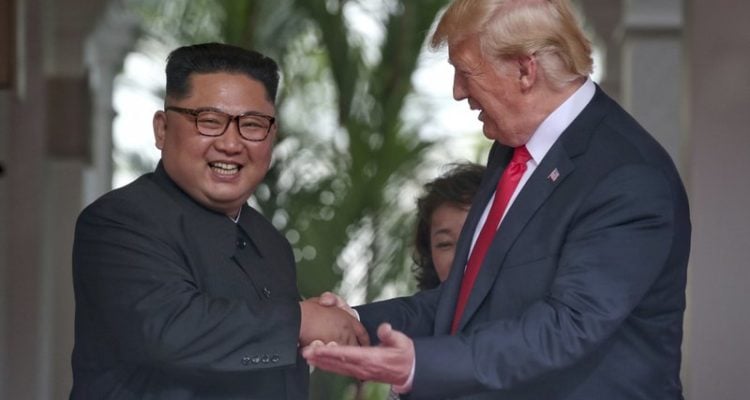By Trump’s own criteria, the pact with North Korea fell short of its objectives.
By: AP
After all the hype, all the vows to tackle what’s perhaps the world’s most urgent crisis, President Donald Trump and North Korean leader Kim Jong Un fell short of the kind of deal the US president himself has long said is needed to settle the North’s decades-long pursuit of nuclear weapons.
For months, Trump has been railing against presidents past, accusing them of an inexcusable failure to solve the nuclear threat emanating from the North. On Tuesday, he patted himself on the back for signing a “comprehensive” pact with Kim paving a path toward denuclearization, but the contours appeared far weaker than even his predecessors’ failed deals.
Rather than a detailed statement filled with concrete restraints on the North, the document seemed to amount mostly to a restatement of long-assumed principles and an agreement to keep talking. And Trump made dramatic on-the-spot concessions to Kim that his own advisers had urged him against, including a halt on “provocative” U.S.-South Korea military exercises and an admission he could be willing to withdraw U.S. troops from South Korea in the future.
“These are all things that Trump is putting on the table as concessions, all in exchange for some vague promises by the North Koreans,” said Paul Haenle, a former China director at the White House National Security Council in the Obama and George W. Bush administrations. He called the language in the joint statement “weak, vague and worrisome.”
In the document, signed with great fanfare by Trump and Kim in Singapore, Kim committed to “complete denuclearization of the Korean Peninsula.” Trump said that process would be starting very soon, adding that once it starts, “it’s pretty much over.”
Easier said than done
Not so simple. Kim has made the denuclearization pledge before. In his April agreement with South Korean President Moon Jae-in, the language was similar, with the two vowing to achieve “a nuclear-free Korean Peninsula through complete denuclearization.”
To be sure, the fact the US and North Korea are now on speaking terms, with a prominent display of nascent rapport among their leaders, augurs a lowering of tensions that likely reduces the chances of a nuclear confrontation in the short term. There will be many in Seoul and Tokyo who are relieved that Washington and Pyongyang are talking up friendship, not potential war.
To that end, there could be something to the notion that if two warring enemies can truly start dealing with each other in fundamentally different ways, then there could be future movement on the nuke issue. North Korea is a top-down nation, and Kim’s word is law. The North Koreans and Americans also decided to hold more talks and likely another leader-to-leader summit, Trump said, an acknowledgement that the issue won’t be resolved in a single day.
Yet line up all the bold claims Trump and his lieutenants made ahead of Tuesday’s summit, and it’s clear that the end result, at least where nukes are concerned, don’t hit the mark. That’s especially striking after last year’s exchange of threats and insults between Trump and Kim, just as North Korea’s torrid weapons testing had many fearing a renewal of the Korean War.
There was irony in the fact that Trump and Kim made direct reference in their agreement to the so-called Panmunjom Declaration between Moon and Kim, with its weak, reheated commitment to denuclearization that lacked specifics at how the rivals would get there. Similarly, there was nothing specific on nukes in Tuesday’s declaration — and no joint affirmation of the goal of “complete, verifiable and irreversible” dismantlement that Trump’s aides had previously made the litmus test for success.
Previous US presidents failed
Since taking office, Trump has repeatedly indicted his predecessors for their handling of North Korea, which launched its atomic program in the 1960s and began producing bomb fuel in the early 1990s. Past administrations have also used a combination of sanctions and diplomacy to seek denuclearization, and have yielded some results that failed to endure.
President Bill Clinton reached an aid-for-disarmament deal in 1994 that halted North Korea’s plutonium production for eight years, halting growth in what was then a very small atomic arsenal. In his final months in office, he also contemplated a summit with then-North Korean leader Kim Jong Il — Kim Jong Un’s father — as the two sides negotiated on also limiting the North’s missile program but ran out of time in office.
George W. Bush took a tougher stance toward North Korea, and the 1994 nuclear deal collapsed amid suspicions that the North was running a secret uranium program. But Bush, too, ultimately pursued negotiations. That led to a temporary disabling of some nuclear facilities, but talks collapsed because of differences over verification.
President Barack Obama made tentative efforts to resume those talks but made little headway. Independent experts estimate North Korea now has enough fissile material for 20 to 60 bombs, and it has tested missiles that could potentially deliver a nuclear weapon to the U.S. mainland.
Trump and Kim? Their document reads like this: “Reaffirming the April 27, 2018, Panumunjom Declaration, the DPRK (North Korea) commits to work toward complete denuclearization of the Korean Peninsula.”
Also missing from the document was something Trump signaled ahead of the summit that could be a major “get”: language committing to end the Korean War, which was stopped by an armistice, not a peace treaty, leaving the Korean Peninsula still technically in a state of war. The closest Trump and Kim got was a vow to “join their efforts to build a lasting and stable peace regime on the Korean Peninsula.”
All this leaves Trump open to criticism that he has given Kim what he has long wanted — recognition, respect and legitimacy on the world stage as an equal — without getting anything substantive on nukes in return.





